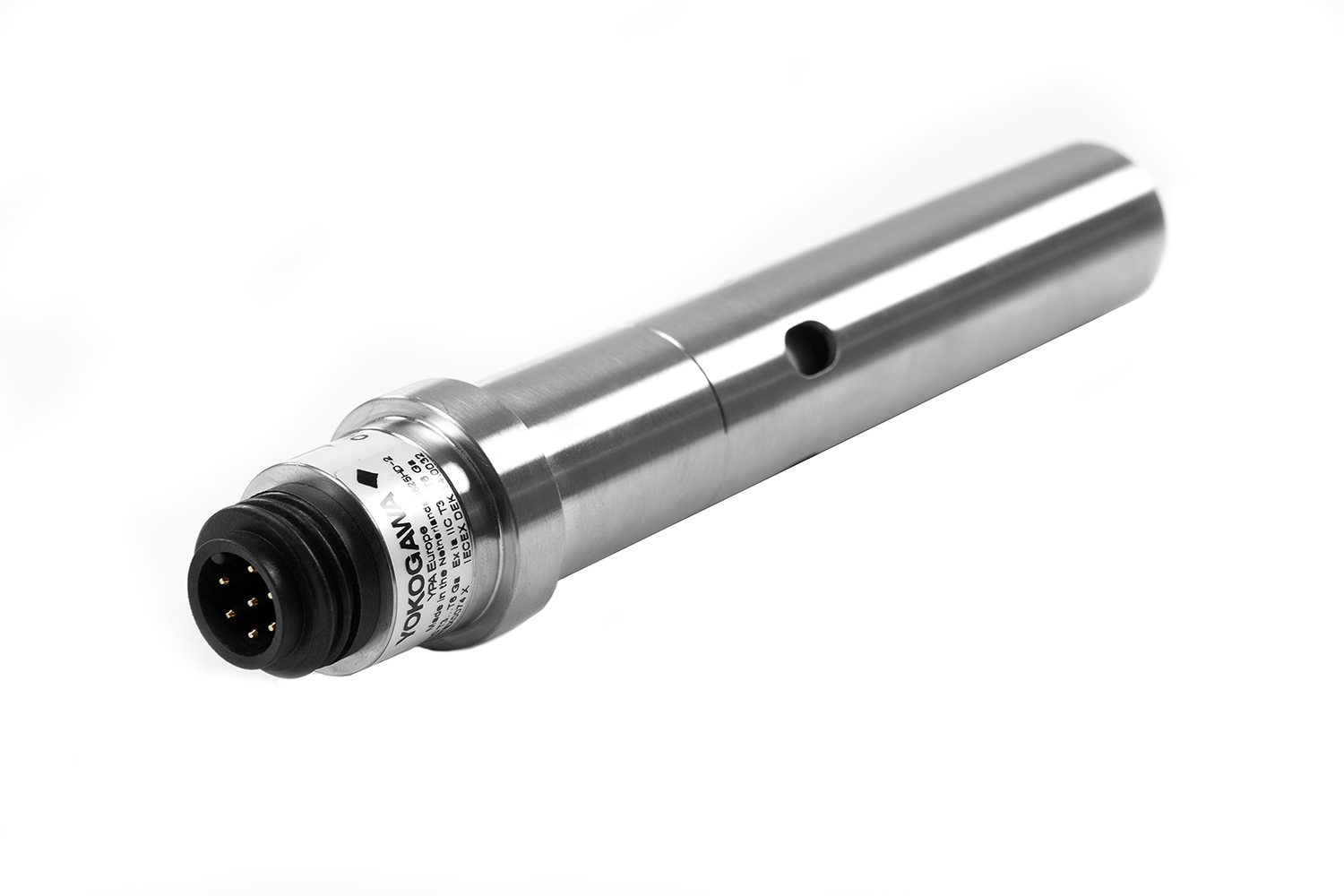Why measure Conductivity?
It can be used as a fairly inexpensive and low maintenance indicator of water quality. Good quality water with little contaminants will have a low conductivity. There is far less maintenance than pH and minimal calibration. Conductivity is used in Boiler feedwater, RO, and Demineralizer applications.
Since conductivity, up to a point, increases with an increase in the concentration of the ions in the process, we can use it to correlate to a % concentration value of solutions such as acids or bases. Again, since conductivity is non-specific, % concentration can only be measured on ONE chemical at a time and not a mixture of contributing chemicals.
There are two basic sensor styles used for measuring Conductivity: Contacting and Inductive (Toroidal, Electrodeless).
When Contacting Sensors are used, the conductivity is measured by applying an alternating electrical current to the sensor electrodes (that together make up the cell constant) immersed in a solution and measuring the resulting voltage. The solution acts as the electrical conductor between the sensor electrodes.
The accuracy of conductivity measurements can be influenced by the following factors:
- Polarization.
- Contamination: Deposits or coating on the electrode surface of a 2-pole cell have a similar effect to polarization errors, i.e. the conductivity reading is lower than usual. These effects can also be prevented with a 4-pole conductivity cell.
- Cable resistance: The cable resistance can induce error in the measurement and must be taken into account.
- Temperature: Conductivity measurements are temperature dependent, if the temperature increases, conductivity increases.
Details
 |
 |
 |
|
| Model Code | SC42 Large Bore | SC4A(J) | SC42 Small Bore |
|---|---|---|---|
| Cell Constants | 0.01/cm; 0.1/cm; 1.0/cm | 0.02/cm; 0.1/cm | 0.02/cm; 0.1/cm; 1.0/cm |
| Ranges | 0.02-2,000 µS/cm; 0.2-20,000 µS/cm; 2.0-200,000 µS/cm | 0.04-400 µS/cm; 0.2-2,000 µS/cm | 0.04-400 µS/cm; 0.4-2,000 µS/cm; 4.0-5,000 µ/cm |
| Temperature Element | Pt1000 | Pt1000 | Pt1000 |
| Pressure Rating | 10 bar/142 PSIG | 10 bar/142 PSIG | 7 bar/100 PSIG |
| Maximum Temperature | 150°C/302°F | 110°C/230°F | 100°C/212°F |
| Installation Connections | Requires FD40, FS40 or FF40 Holder | 3/4" NPT Fitting; 1", 1.5" or 2" Tri-Clamp; Retractable | 3/4" NPT Fitting; 1", 1.5" or 2" Tri-Clamp |
| Integral Cable | NO | YES | YES |
| Materials Of Construction | 316 Stainless Steel | 316 Stainless Steel or Titanium | 316 Stainless Steel or Titanium |
| Design Sytle | 2-Electrode | 2-Electrode | 2-Electrode |
Ressources
Process liquid analyzers such as pH meters, conductivity meters, ORP meters, and density meters play an important role at electrolysis plants in the control of concentrations of various process solutions. This requires both precision and stability under harsh conditions that include highly corrosive substances, high temperatures, and many impurities.
Seawater leak detection is the post-condensation water quality management processes. Damage to the ion exchange resin, which deionizes the supplied water, is also monitored during this process, and both of these applications are executed by a conductivity analyzer. (AN10D01P01-01E)
To defray energy costs, many industrial plants have their own boilers to generate steam in order to produce a portion of their energy needs. In addition to generating power, the steam may also be used directly in plant processes or indirectly via heat exchangers or steam jacketed vessels.
There are a number of suppliers of oil and fat products used for edible purposes. These products include, but are not limited to olive oil, peanut oil, soybean oil, sunflower oil, lard, shortening, butter, and margarine. The raw materials for these products include animal by-products, fleshy fruits (palm and olive), and oilseeds.
Industry:Food and Beverage
Reverse osmosis (RO) is a separation process that uses pressure to force a solution through a membrane that retains the solute on one side and allows the pure solvent to pass to the other side. More formally, it is the process of forcing a solvent from a region of high solute concentration through a membrane to a region of low solute concentration by applying a pressure in excess of the osmotic pressure.
Downloads
Instruction Manuels
Général Spécifications
- Model SC4A Conductivity Sensors and Fittings for 2-electrode Systems (1.3 MB)
- Model WU40 Sensor Cables (592 KB)
- Model SC42 2/4-electrode design for Contacting Conductivity (3.1 MB)
- Model SC42 and FF40/FS40/FD40 2/4-electrode design for Conductivity Flow fittings, Subassemblies and Immersion fittings (1.4 MB)
Technique Information
- Conductivity Analyzer Selection Guide (871 KB)
- Contacting Conductivity sensor selection guide (1.6 MB)
- SENCOM 4.0 Platform: Grounding (3.6 MB)
Certificats
- EU_UK Declaration of conformity SC49 2022-10-03 (114 KB)
- EU_UK Declaration of Conformity QT11 2022-11-14 (103 KB)
- EU Declaration of conformity SC42 large bore (84 KB)
- IECEx_DEK_14_0032X_Issue 0 SC4A, SC42 and SX42
- DEKRA 14ATEX0074X-Issue 2 -E SC4A, SC42 and SX42 (309 KB)
- Certificate of Conformity IECEx SC4A SC42 SX42 (60 KB)
- IECEx_DEK_14_0032X_Issue 1 SC4A, SC42 and SX42 (986 KB)
- EU_UK Declaration of Conformity QT11 2022-11-14 (103 KB)
- KCs_SC42(21-KA4BO-0419X) (156 KB)
- KCs_SC42(21-KA4BO-0420X) (157 KB)
- DEKRA 14ATEX0074X-Issue 1 SC4A, SC42 and SX42
- IECEx_DEK_14_0032X_Issue 0 SC4A, SC42 and SX42
- TS_SC4A SC42,SX42 (1.7 MB)
- EACEx_SC4A SC42,SX42 (3.7 MB)
- PESO_SC4A SC42,SX42 (98 KB)
- Ex NEPSI_SC4A SC42,SX42 (917 KB)
- EU_UK Declaration of conformity SC42 2022-10-03 (158 KB)
- EU_UK Declaration of conformity SC41 2022-10-03 (125 KB)
- FM20US0123X FU20, FU24, SC25V, SC4A, SC42, SX42 (410 KB)
- EU Declaration of conformity SC4A (90 KB)
- SC42/SX42/SC4A ATEX/ IECEx (2.3 MB)
- FM20CA0062X FU20, FU24, SC25V, SC4A, SC42, SX42 (390 KB)
- EAC certificate for sensors (1.8 MB)
Vidéos
Check out what is in the box when you receive Yokogawa epoxy type conductivity sensor SV42-EV15.
Rechercher plus d'informations sur nos compétences, technologies et solutions
Contactez-nous








